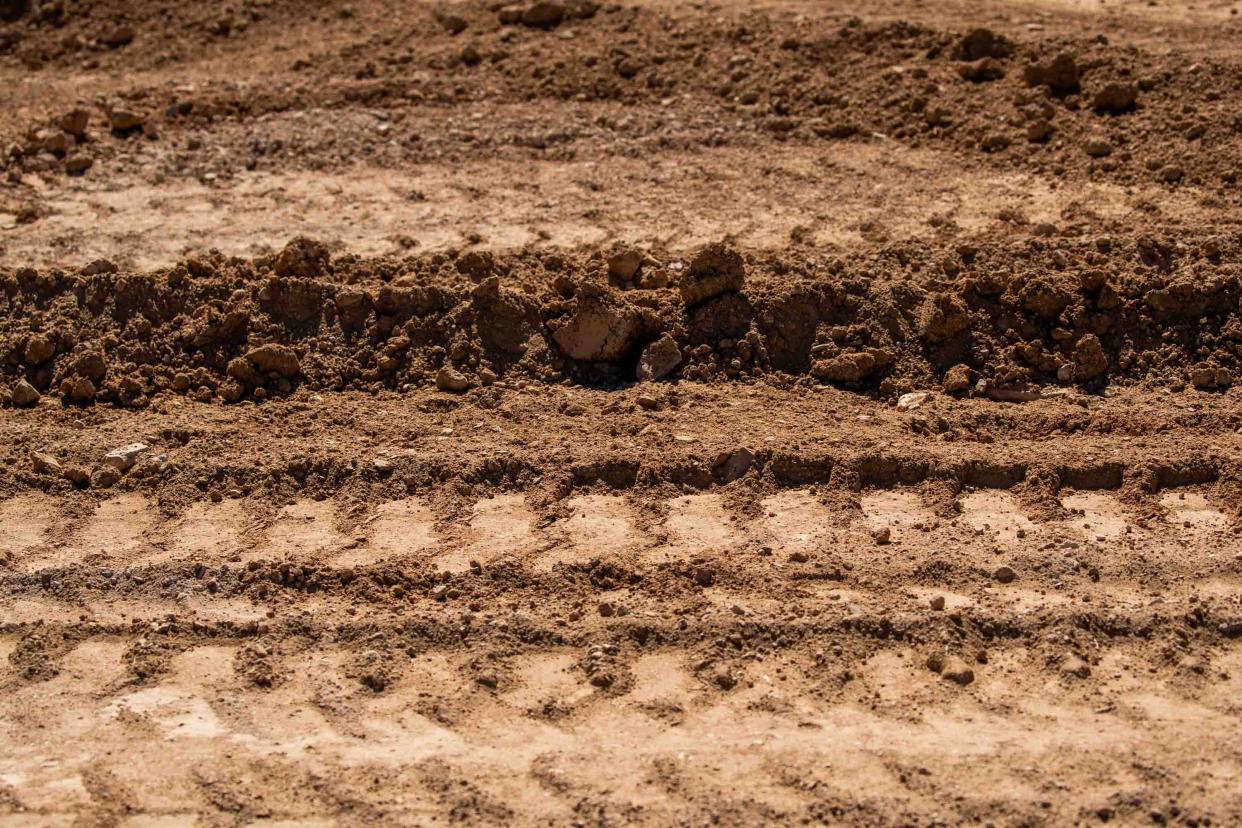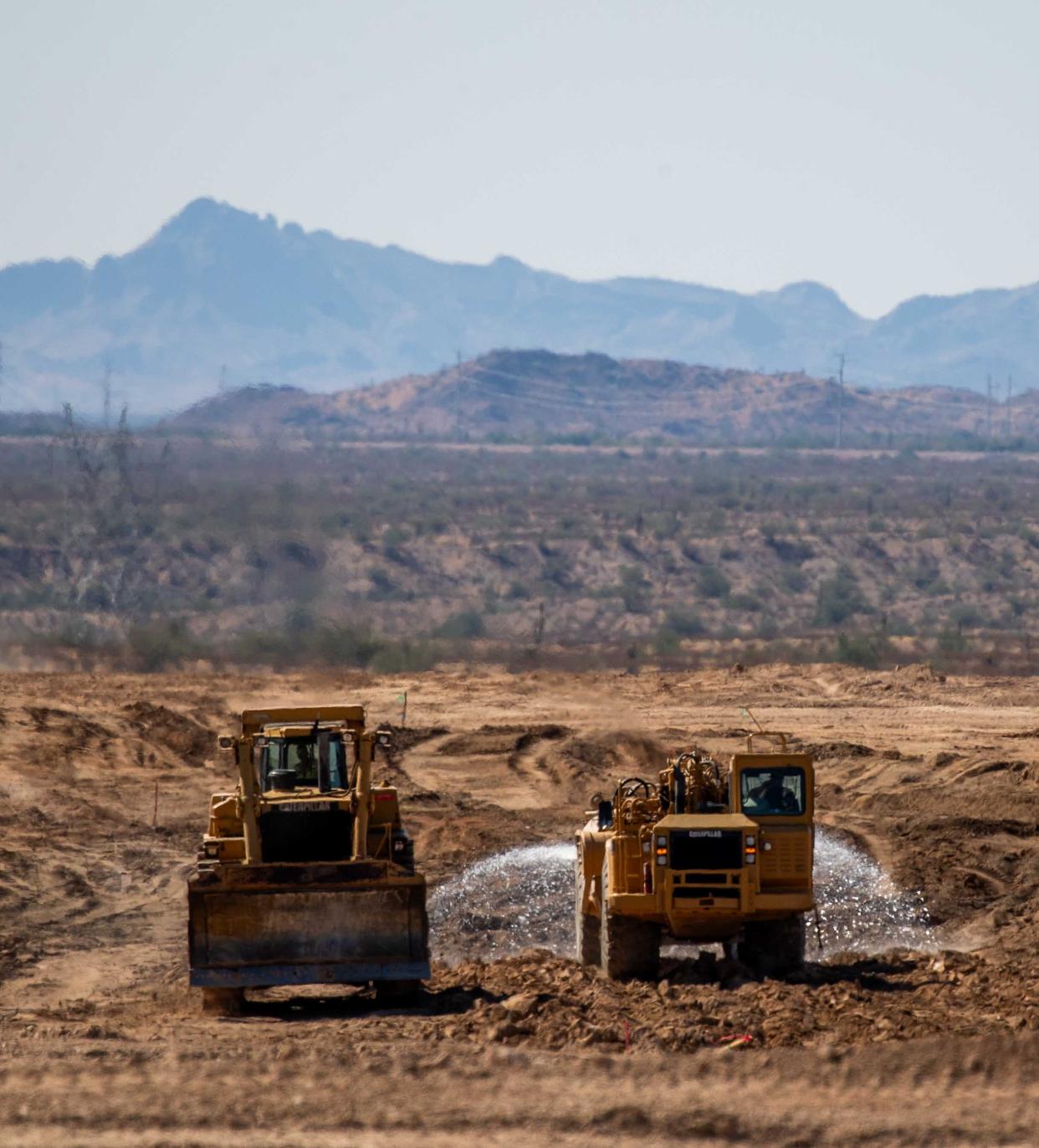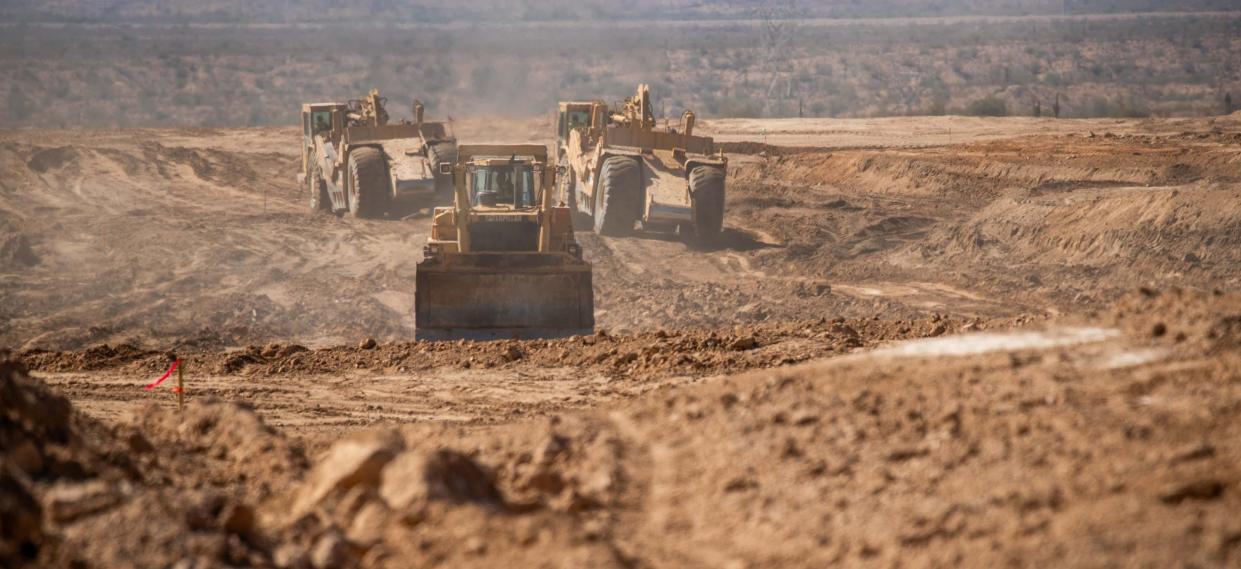Buckeye's master-planned Teravalis, once Douglas Ranch, in legal dispute over groundwater
Buckeye's ambition to build the largest master-planned community in Arizona is tied up in a legal battle over whether the developer has enough groundwater to make it a reality.
When developer Howard Hughes Corp. broke ground on the first phase of the project last year, court records show that it had the necessary water supply for about 3,000 aces of the 37,000-acre subdivision.
A portion of the community's conditional groundwater rights had expired in 2020. The Arizona Department of Water Resources declined to extend the rights, a move the developer is arguing was illegal.
The dispute centers on a hydrological study that Douglas Ranch, now Teravalis, was to submit that would have reserved a portion of groundwater for 10 years. Because the study never was submitted, the department declined to extend what it calls a conditional analysis, the only such special consideration it ever granted, water officials said.
Douglas Ranch appealed that decision to an administrative law judge and lost. The current developer, the Howard Hughes Corp., renamed the development Teravalis and in August appealed that decision to Maricopa County Superior Court. The case likely will stretch into 2024.
Teravalis could become one of the largest master-planned communities in the country. But if developers can't find available groundwater, they will have to find alternative sources of water before the next phases of development can begin, experts say, adding that it's unclear where it will come from.
What is Teravalis?
Texas-based Howard Hughes Corp. acquired the property for $541 million in October 2021 from JDM Partners and El Dorado Holdings, both of which are based in the Phoenix area.
The massive development is roughly halfway between Tonopah and Wickenburg and largely west of the Hassayampa River.
The Howard Hughes Corp. renamed it Teravalis and broke ground on the first phase of development for a village called Floreo in October 2022. JDM Partners and El Dorado Holdings are still 50/50 joint venture partners with the Howard Hughes Corp. on Floreo.
JDM Partners re-acquired a stake of $65 million, or 12%, in the rest of Teravalis in August 2022.
JDM Partners and El Dorado Holdings did not respond to requests for comment for this article.
Teravalis has been in the planning stages for 25 years. The 37,000-acre, or about 57-square-mile, community eventually could be the size of Flagstaff with a population of 300,000 people, which is more residents than Scottsdale currently has.
The Howard Hughes Corp. is hoping for a grand opening in 2025, with Floreo taking between seven and 10 years to complete, Heath Melton, president for the Phoenix region of the Howard Hughes Corp., told The Arizona Republic last month.
What is an analysis of assured water supply?
Melton told The Arizona Republic that it had two water supply certificates, ensuring enough water from the Hassayampa sub-basin, enough to supply all of the Floreo village's eventual 5,000 rooftops.
But that village is only about 3,000 acres, leaving the question of where water will come from for the rest of the 37,000-acre master planned community.
If a city does not have a designation of assured water supply from the Arizona Department of Water Resources — which proves that the city has enough water to sustain growth for the next 100 years — all developers must obtain a certificate of assured water supply.
That certificate is also granted by the state Water Department and proves that the developer has enough water to supply that subdivision for the next 100 years. Designations also can be awarded to towns and private water companies.
But getting such a certificate can be a long, tedious process, leaving the option of seeking analyses of assured water supply.
An analysis is a determination by the state Water Department that some of the requirements of an assured water supply have been met. It is almost always issued to master-planned communities, said Kathleen Ferris, senior research fellow at the Kyl Center for Water Policy and a former state Water Department director.
When developers apply for an analysis, they're typically looking for a determination from the state Water Department to see how much groundwater is available. Once the analysis is granted, that groundwater will be reserved for the developer for 10 years. It can be extended for five-year periods as long as some requirements are met, Ferris said.
Melton previously told The Republic that two analyses of assured water supply are in place for the rest of Teravalis. One of those was obtained in 2004 and has been extended. The conditional analysis first was obtained in 2009.
Earlier this year, the Water Department released a report showing groundwater in the Phoenix area has been overallocated. Consequently, the state announced it won't issue any more certificates based on groundwater in the Phoenix Active Management Area, a zone that includes most of the metro area that is subject to certain groundwater regulations.

That means that, by law, the Howard Hughes Corp. will be unable to turn those analyses into certificates and will have to find another source of water for the rest of the 100,000 homes slated for Teravalis.
Rhett Larson, the Richard Morrison professor of water law at Arizona State University's Sandra Day O'Connor College of Law, said that it still might be worth it for some developers to have an analysis even though they no longer can be turned into certificates.
If the cost is relatively small to get an analysis, some developers might think it's worth it to have that supply of groundwater locked down so no one else can take it. There is already a tremendous amount of political pressure on Arizona Gov. Katie Hobbs to loosen groundwater rules, which might be causing developers to think the analyses could be useful in the future, Larson said.
Spencer Kamps is vice president of legislative affairs at the Home Builders Association of Central Arizona and also sits on the Governor's Water Policy Council. Analyses originally were developed as a tool by the housing industry in conjunction with the state Water Department to secure water for projects that take 15 to 20 years to sell the first home. That's because of all of the planning and infrastructure costs that go into large projects like a master-planned community, Kamps said.
Why are ADWR and Howard Hughes in court?
But court records obtained by The Arizona Republic show that the Department declined to extend one of Teravalis's analyses that would be used for the last four phases of the development.
The analysis was granted to what was then Douglas Ranch and El Dorado Holdings in 2009, applying for a five-year extension in 2018 when the development was stilled called Douglas Ranch. The water department denied the extension in 2020 in a move that Douglas Ranch argues goes against the law.
The Howard Hughes Corp. took over the case when it acquired the property in 2021. It is referred to as Doulgas Ranch in all court documents.
The state water department issued Douglas Ranch a conditional analysis in 2009, along with several other subdivisions that would rely on the Hassayampa sub-basin: Belmont, Festival Ranch and Sun Valley South.
It was the first and only time the agency ever has issued conditional analyses, according to court documents. While the reasoning behind why the Department issued those conditional analyses at all is unclear, Howard Hughes Corp. is arguing that the denial is based on a policy disagreement with its prior leadership.
The Department reviewed a 2006 Hassayampa sub-basin model submitted by Douglas Ranch and the other developers in 2009. It didn't prove it could secure adequate water, so the state didn't issue the analysis. But the Department issued a conditional analysis because it did determine about 26,000 acre-feet of groundwater and effluent water per year would be available if certain conditions were met.
Under the conditions in the analysis, Douglas Ranch was to submit a hydrologic study within one year, based on that 2006 model with the other subdivisions. That study would identify the total volume of groundwater available to Douglas Ranch for the next 100 years.
In 2010, Douglas Ranch requested the state water department waive the requirement for the study. Douglas Ranch cited the economic downturn and the better use of resources elsewhere.
The Department waived that requirement in 2010, which effectively waived another requirement dependent on the study. All other conditions listed in the analysis were still in effect, according to a letter sent by the Department to lawyers for Douglas Ranch. One of those conditions stated that Douglas Ranch can submit a hydrologic study at any time to demonstrate the groundwater that is available.
But the Department argues that Douglas Ranch was still required to prove the availability of groundwater. And to do that, they would have to submit a hydrological study, with the condition being waived to simply give Douglas Ranch more time.
Because Douglas Ranch never followed up, the Department denied the extension.
Douglas Ranch then appealed that decision, with administrative law judge Velva Moses-Thompson upholding the water department's decision to deny the extension in an April 2023 hearing.
David McKay, manager of the recharge and assured and adequate water supply programs at the Department, said during legal hearings in April that the decision to waive the condition was merely to allow Douglas Ranch more time to prove how much water was available.

Analyses must meet one of the seven criteria required to obtain a certificate of assured water supply. But while the Department has rules regarding analysis of assured water supply and extensions, none of those rules mention conditional analysis of assured water supply.
"From my review of everything that happened in 2009, those conditional analyses were somewhat of an anomaly. It wasn't something that the Department did or has done since. So, I'm not sure what was part of the decision at that time," McKay said during the hearing, according to court documents.
The decision was based on the condition that an adequate water supply would exist, McKay said. That would have been up to Douglas Ranch to prove.
But because Douglas Ranch never showed that, the Department never received an analysis and therefore no amount of water was ever reserved, the Department argued in court documents. And that would mean there was nothing to extend.
In 2009, the state water department's assistant director Sandy Fabritz-Whitney issued the conditional analysis, before becoming director in 2011.
When asked if the state water department violated its own rule by issuing the conditional analysis, McKay said that would be up to interpretation because it was conditional.
Douglas Ranch is also arguing that the 2006 Hassayampa sub-basin model demonstrates the needed amount of groundwater.
When tested during simulations, the 2006 Hassayampa sub-basin model didn't show the amount of water that Douglas Ranch was asking for, according to court documents. That's why the analysis was made conditional, McKay said. Another study would have to have been submitted and that never happened.
Because there is no rule regarding conditional analyses, the case gets into the technicalities and specifics of groundwater rules.
The state water department is required to extend an analysis if the developer makes substantial capital investments. Douglas Ranch lawyers argued that the millions of dollars invested in Teravalis should have fulfilled this requirement.
How does water impact development?

In a statement to The Arizona Republic, Melton said Howard Hughes Corp. is committed to collaborating with Hobbs, the state water department and local stakeholders "to ensure that Arizona becomes a national leader in responsible water management and sustainable growth."
He declined further comment for this report.
The Valley's development depends on guarantees of adequate water.
One of the first things investors look for before financing a project is whether or not it has water, Kamps said. An analysis serves to hold that water through the planning process.
If a subdivision is not in the area of a designated water provider, such as a city or private utility company with a designation of assured water supply, developers will seek a certificate of assured water supply.
But they also have to replenish all groundwater that is being used for the homes in that subdivision, typically by enrolling the homes in the Central Arizona Groundwater Replenishment District, Kamps said.
Within the area of a designated provider, all land uses need to replenish the aquifers, including commercial and industrial development.
But within areas like Buckeye and Queen Creek, which don't have a designation of assured water supply, only for-sale housing has to replenish the aquifers, Kamps said. That means industrial and commercial developers do not have to obtain a certificate of assured water supply and do not have to replenish the aquifers.
But the department isn't issuing any more certificates based on groundwater within the Phoenix Active Management Area, which is going to cause an influx in facilities like data centers while homes can't be built. Ultimately, that is going to use up the groundwater, Kamps said.
"We've allowed other land uses to continue to pump groundwater without replenishing it, resulting in our groundwater tables declining. And that's not good," Kamps said.
More than $1 billion has been invested in a vast, growing area of Buckeye west of the White Tank Mountains and south of Wickenburg. And those projects, including Teravalis, not being able to build puts them at a significant financial risk, Kamps said.
Kamps said he doesn't agree with adding more commercial and industrial development to the Assured Water Supply program. It was initially meant as a consumer protection measure. But with industrial development and commercial development able to use the same groundwater, Kamps said those consumers aren't really protected after all.
Instead, Kamps said those land users should do more to offset their groundwater use. Ultimately, Kamps said more conversations need to happen to figure out the best way to approach conserving groundwater and balancing development.
Ferris, who helped craft Arizona's 1980 Groundwater Management Act, worked hard to make sure that the Assured Water Supply program was included because groundwater is finite, taking thousands of years to replenish itself. It was understood at the time that growth would be limited in areas that didn't have access to renewable water supplies or surface water, Ferris said.
But that caused outrage among developers who owned land in those areas, with people pushing for the Central Arizona Groundwater Replenishment District as a way to allow more growth relying on groundwater. That diminished the incentive to grow in an area with a designated provider, resulting in growth on raw desert land and, consequently, leading to the state's current groundwater situation.
Although the Central Arizona Groundwater District has to acquire water supplies to replenish groundwater, Ferris said the state water department has determined a deficit. Ultimately, Ferris said Buckeye is likely going to have to find alternative water sources to continue development.
In an email, Buckeye spokesperson John O'Halloran said the city is not involved in the legal proceedings between Teravalis and the Department. The city declined to comment further for this report.
The city is looking toward other options when it comes to finding water, O'Halloran said. Those are all outlined in Buckeye's Water Resources Master Plan, such as using reclaimed water and partnering with other cities to expand the capacity of the Bartlett Dam.
Sandy Bahr, director of environmental organization Sierra Club's Grand Canyon Chapter, has been advocating for changes to surface and groundwater laws at the state level. But so far there hasn't been any success in tightening up water laws, Bahr said.
Bahr said the state likely needs to limit development due to the state's current groundwater situation. In addition to the obvious problems like residents not having water, over pumping groundwater can create fissures in the earth and land subsidence, which refers to the gradual sinking of the earth's surface. And those aren't fixable, Bahr said.
"It's water that has been there for thousands of years. And we should continue to treat it like the precious resource that it is," Bahr said.
Reach the reporter at ahardle@gannett.com or by phone at 480-259-8545. Follow her on X, formerly Twitter: @AlexandraHardle.
This article originally appeared on Arizona Republic: Buckeye's Teravalis in legal battle with state water department
